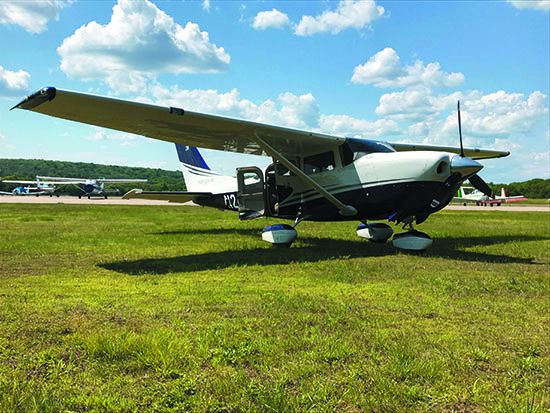It’s big, beefy, has plenty of power and is just as capable on water floats as it is on wheels. Indeed, Cessna’s venerable 206 Stationair long ago earned its reputation as a flying SUV. Load it with people, cargo and even small motorcycles. And better yet, with the right instruction, transitioning to a Stationair is straightforward.
Plus, 206 ownership is easy because like other Cessna piston singles, most shops can easily wrench them. So popular has been the 206’s combination of simplicity and load-carrying that it’s one of three singles Cessna saw fit to bring back to the land of the living when it restarted piston production. Today, while prices for good ones are up (like most singles), there are plenty of decent 206s on the market. Here’s a look at the current market. First, some history.
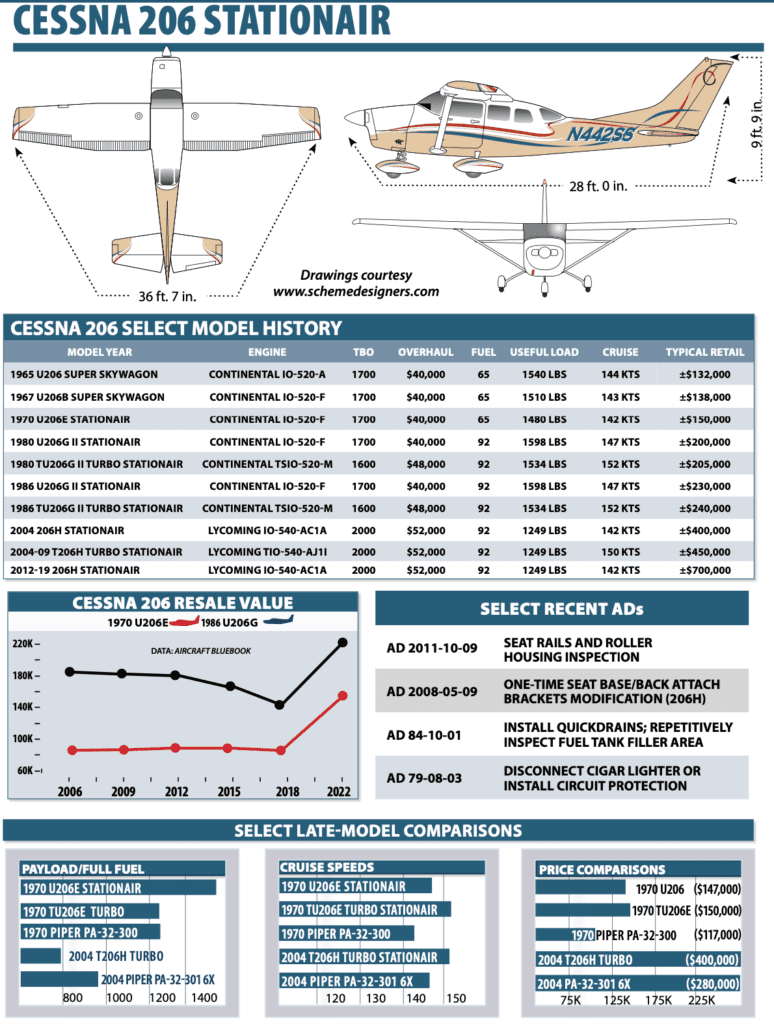
MORE THAN A SUPER 182
What ultimately became the 206 Stationair was originally introduced in 1963 as the 205, a fixed-gear 210, technically known as the 210-5. It had two doors up front and a relatively small rear door on the left side. The engine was a 260-HP Continental IO-470. This airplane was a fixed-gear version of the recently revamped 210; it was produced for two years, with 577 delivered. Keep in mind that Cessna’s biggest fixed-gear piston single is really three models, though all are essentially the same airframe.
In 1964, Cessna responded to demand for more utility and created the U206 (U for “utility”) Super Skywagon, with a 285-HP Continental IO-520-A, redesigned wing and bigger flaps. Intended as a flying pickup truck, even the seats were optional. There was one door for the pilot and a big double door aft on the right side.

The next model year saw the 205 become the P206 Super Skylane, with “P” representing “personal” or “passenger,” depending on with whom you’re speaking. The P206 had the same door arrangement as the 205, but with the bigger engine from the 206. The U206 was by far the more popular of the two.
In 1967, the U model got a takeoff-weight boost and a new engine, the 300-HP Continental IO-520-F, while the P model kept the 285-HP O-520-A. Turbocharging became available on both variants in 1966, with a 285-HP Continental TSIO-520-C. The P206 was discontinued in 1970, with a total production run of 647. The remaining U206 and TU206 were offered with either a utility or passenger interior, and renamed Stationair.

A stretch of the fuselage brought into being the 207 Skywagon in 1969, powered by the 300-HP IO-520-F. One more seat was added, bringing the number available to seven. Useful load went up by about 30 pounds. An additional bonus was a nose baggage compartment, easing the task of getting the CG in the proper place during loading. The turbo model of the 207 was powered by a TSIO-520-G, also with 300 HP.
Camber-lift wings, which feature a slightly cuffed leading edge, were added in 1972. These improved low-speed handling at almost no cost to cruise speeds. At the same time, the baggage compartment got a 7-inch stretch. An aerodynamic cleanup in 1975 boosted cruise speed by about 6 MPH. The cleanup included more-streamlined wheel pants and improved cowl flaps.
In 1977, the horsepower of the turbo engine was upped to 310 (for takeoff only) on both the TU206 and the T207. A wet-wing fuel system was introduced in 1979.
In 1980, another seat was added to the back row of the 207, making it an eight-place airplane. This created the Stationair 8, but the Cessna designator remained Model 207. The world would have to wait for the Caravan to see a Model 208 and what may be the ultimate evolution of the high-wing, strut-braced single. The 207 was discontinued in 1984, and the 206 two years later. It was a great run.
Along the way, 206s saw several suffixes added, starting with the 206A in 1966 and culminating, temporarily, with the 206G in 1986. More than 7000, by serial number, U206s had entered the market, along with 647 P206s, the 577 aforementioned 205s and another 788 207s.
But then a funny thing happened: In the mid-1990s, Cessna started making piston-powered airplanes again. After starting up assembly lines for the 172 and 182, the Model 206 returned in 1998 as the 206H, powered not by a Continental IO-520 but by a normally aspirated 300-HP Lycoming IO-540-AC1A. It was joined by the T206H, powered by a turbocharged 310-HP Lycoming TIO-540-AJ1A.
Cessna stopped production of the normally aspirated 206 somewhere around 2013, but has kept going with the T206H and in 2022 is selling them for we’ll north of $700,000. Unlike the Continental-powered 206s, the H model is available with a five-place, club-seating option.
LOAD UP THE CABIN
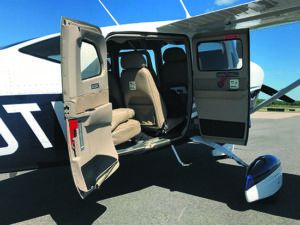
Of course, that’s why most people buy a Stationair in the first place. While no airplane can handle anything you can fit in it, the Stationair comes closer than most. Full-fuel payloads of 1000 pounds or better are not at all uncommon.
The big rear cargo doors—creating an opening more than 44 inches wide—make getting bulky cargoes inside less of a chore than in other aircraft. Another nice touch is the lack of a lip at the doors, so cargoes don’t have to be maneuvered up and over to get them inside—it makes a big difference.
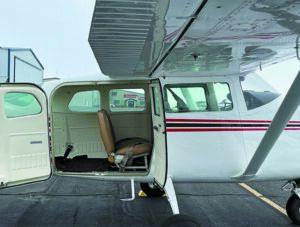
The airplane can be flown with the cargo doors off which, combined with solid low-speed handling, makes it popular with aerial photographers and public benefit flying organizations involved in conservation research and monitoring. Public benefit flying organizations LightHawk and CAVU have owned multiple 206s, using them in remote areas.
Specialty kits were made available so the Stationair could take on such jobs as glider towing, parachute jumping and even aerial hearse service. There also is a cargo pod available. When using a cargo pod, make sure you follow any limitations on flap deflection that are on the STC for the installation.
With or without the cargo pod, the Stationairs offer ample loading flexibility. The allowable CG range is unusually long, making cargo/passenger positioning less of a juggling act than with many aircraft. However, despite some pilots’ assertions that “If you can get it in, you can take off,” weight and balance computations are not optional. Plenty of accidents over the years show it is possible to load a Stationair outside its envelope.
As for cabin comfort, newer Stationairs are nicely appointed, but these airplanes aren’t exactly flying Cadillac Escalades. While the Stationairs have large cabins, they’re not long on comfort with a full load of passengers. Noise levels, particularly during takeoff and climb, can be fairly high as piston-engined singles go. And the rearmost seats—row three in the 206, rows three and four in the 207—leave little in the way of legroom.
Another comfort consideration is the baggage compartment. In spite of Cessna’s best efforts, it doesn’t quite match the capabilities of the passenger compartment. As a result, passengers may find themselves sharing space with their bags. Again, if you routinely carry big loads, invest in a cargo pod.
PERFORMANCE
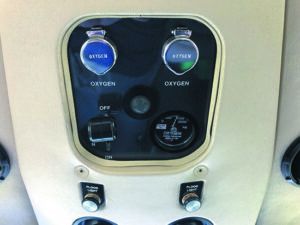
These airplanes won’t win speed races, and they don’t exactly come out on top for fuel efficiency. Top cruise speeds will run in the 145-knot area while burning 17 gallons per hour or more. Throttling back to a more leisurely 135 knots cuts fuel consumption to a more reasonable 13 GPH. Operating LOP can reduce those numbers 2 or 3 GPH while keeping CHTs down—a consideration in hot climate operations.
Handling matches the aircraft’s size—it’s not like a flying sports car. Pilots who transition to the Stationair after climbing the Cessna model ladder may find the aircraft is just more of the same—only heavier, although the ailerons are notably responsive, even at slow speeds. Few owners seem to mind the fairly heavy controls because face it, snappy handling is not why they bought the airplane.
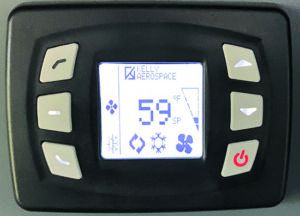
This is not without its benefits, though. It makes the Stationair an excellent IFR platform—stable and rock-solid. It also makes for a relatively smooth ride in turbulence.
Another benefit is that the Stationair is reluctant to stall. Pitch forces are fairly heavy to begin with. Compounding this is the generally nose-heavy loading of the airplane. Since the CG envelope is so long, and most everyone wants to sit up front, the CG is often at or near its forward limit. Also, with power on, the deck angle required for a wings-level stall is alarming. Put it all together and the Stationair is not generally a willing participant in stalls. If you do stall the airplane, the behavior is pure Cessna: There is a definite break and it will roll off if the ball is not centered. Recovery requires lowering the nose by at least relaxing back pressure. When heavy, especially with full flaps, it may take some altitude before you can establish a positive rate of climb. Transition training should include practicing balked go-arounds with full flaps deployed. Learn to trim, too.
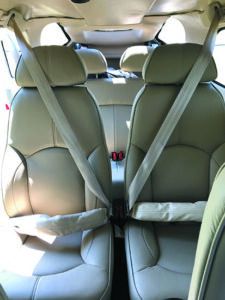
A drawback of the forward CG tendency is a proclivity for inexperienced 206 pilots to arrive nose first during landing, especially at light weights. It takes a hefty pull on the yoke to flare properly. Thus, Stationairs are no strangers to hard, nose-first landings that sometimes damage the aircraft. In the 207, the nose baggage compartment can simply add to the nose heaviness. However, using less than full flaps for landing (say only 20 degrees) can ease the control forces required to flare, and so can the loading configuration.
When loaded toward the aft CG limit, the equation changes significantly. It doesn’t take nearly as much effort to flare to land. A pilot who isn’t ready for the lighter control forces can get surprised at how easy it is to get the nose up.
The 206 can feel like two different airplanes when it is light with a forward CG versus at gross weight and a mid- to aft-CG loading. We strongly recommend that any checkout in a 206 include time with the airplane loaded light and forward and heavy and aft. Part of that should be what it takes to get to the runway when heavy, with full flaps and slow. Be prepared to put the throttle to the stop.
Like most Cessna singles, the 206 does pretty we’ll in short/soft/rough field operations, a big factor in the purchase decision for many of our respondents. Early models had 40 degrees of flap, which helped tremendously for short arrivals. However, the airplane just won’t climb with that much aluminum hanging out in the breeze. Cessna later limited flap travel to 30 degrees.
WRENCHING IT

It’s a Cessna piston single, so finding a shop to work on a 206 is easy. Moreover, simplicity is a good thing, and helps keep maintenance costs down. But on the other hand, Stationairs are working airplanes by and large, and wear and tear can easily turn the tide in the other direction. Turbocharged engines add to the complexity, of course. And aging Stationairs aren’t immune to corrosion issues, like other aircraft.
We’ve seen problems with the tail, mostly corrosion caused by the foam-filled elevator and trim tab getting soaked with water and pulling off rivets, screws and nuts—a concern if the airplane was ever on floats.
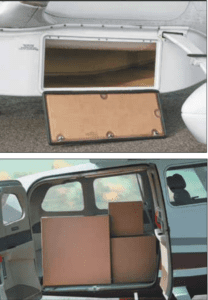
Some of the brackets in the tail can crack. There have also been some instances of cracking door posts, though these problems have not proven to be a safety issue.
Given the number of respondents who routinely operate out of short and rough fields, combined with the nose-heavy landing tendency, we recommend paying close attention to the landing gear, brakes and the prop for erosion from the detritus on backcountry strips.
There have been a couple of 206/207 specific ADs: 85-2-7 calls for inspection of a roll pin in the fuel selector, and 85-10-2 mandates recurrent inspection or modification of the induction air box.
Other ADs of note are 91-15-4 and 82-27-2, inspection of the prop; 97-26-17, ultrasonic inspection and possible replacement of the crankshaft; 96-12-22, recurrent inspection of the oil filter adapter; and 2011-10-09, seat rails and roller housing inspection.
The 206/207 is subject to the infamous 84-10-1 fuel tank bladder AD.
MODS, SUPPORT
There’s probably a modification available for the 206/207 to allow it to do most anything someone might want. This includes skis, floats, long-range tanks, STOL kits, vortex generators, cargo pods and various speed mods.
One can even opt for an STC’d 450-SHP Rolls-Royce turboprop engine, courtesy of Soloy (www.soloy.com). If that is too much, and the factory IO-520 isn’t enough, maybe an IO-550 from Texas Skyways (www.txskyways.com) would be another solution.
Vitatoe Aviation in Circleville, Ohio, offers cross-flow cylinder and induction upgrades for IO-520 engines and an STC’d IO-550 upgrade. It also has a variety of engine mods for the 210 Centurion. Visit the company webpage at www.vitatoeaviation.com for performance specs.
CAV Ice Protection has the weeping wing TKS upgrade for 206 F, G and H models. Visit them at www.caviceprotection.com and read our full report on de-ice system upgrades in the February 2021 issue of Aviation Consumer.
As far as type clubs, there’s the Cessna Pilots Association (www.cessna.org), which as we recently reported is getting back up to speed. There’s also the Cessna Flyer Association (www.cessnaflyer.org). There are also a few active Facebook groups catering to Cessna 206 owners and pilots.

We’ve never selected a geographic area as the most common cause of aircraft accidents in the Used Aircraft Guide, but after reviewing the 100 most recent Cessna 206 crashes, we’re doing so—Alaska is where Cessna 206s go to die.
Nearly one-quarter of all Cessna 206 wrecks occurred within the 49th state. The need to use general aviation aircraft to get around the massive state coupled with treacherous weather, intense pressure on pilots to go regardless of weather and aircraft condition, questionable maintenance, pilot fatigue plus pilot egos writing checks their skills and judgment can’t cash take a disproportionate toll on the Cessna 206 population.
Cessna 206s are working airplanes—in our opinion one of the best load-hauling piston-engine airplanes ever built. Plus, they have an amazingly long CG range that makes flaring to land quite different when loaded forward versus aft. At the same time, the 206 series has very effective controls and a gear geometry that allows them to be landed safely in strong crosswinds.
We classified 31 percent of the accidents as runway loss of control (RLOC) because we didn’t have enough space to add “hard/bounced landings.” Many were nosewheel-first touchdowns that translated into PIO and hitting hard enough to break off the nosegear. Several landing (and takeoff) accidents reflected the Alaska factor—pilots landed on beaches and discovered that the surface wasn’t what they’d hoped and lost control or hit something.
We felt for the pilot who made a beach landing only to have the main landing gear break off due to fatigue cracks that had never been detected in years of maintenance.
One pilot started his takeoff roll on the left side of a soft runway to avoid a bad dip in the center. He lifted the nosewheel right away but didn’t get on the right rudder pedal firmly enough, drifted left and hit a nearby bulldozer.
A pilot taking off from an Alaskan road hit a sign with the left wing—and pressed on to his destination. After landing and noting the “substantial” damage to the left wing, he said that the 206 had flown with a “slightly left-wing heavy feel” on that leg.
Another pilot experienced a gust on the takeoff roll, didn’t counter it, went off the runway, hit a helicopter and launched. He opted to return and land, which he did safely.
For an airplane in which the pilot has to decide which tank to use in flight, we found only seven fuel-related accidents. Most were due to fuel exhaustion but two involved pilots who didn’t switch into the fuller tank prior to landing—as called for in the POH—ran a tank dry on final, switched tanks, but didn’t turn on the boost pump—as called for in the POH—and didn’t get a restart prior to touchdown short of the runway.
More than half of the engine stoppage events were due to improperly performed maintenance, mostly under-torqued cylinders. Although we do question one gravel bar overshot landing into a river that the pilot said was a forced landing after engine failure. However, the engine was never made available for inspection and the logbooks were “washed downstream out of the airplane.”
FEEDBACK

I own a 1999 T206H and base it at Glacier Park International Airport in Kalispell, Montana. I purchased the plane in 2018 and I’m the second owner. It had only 619 total hours when I purchased it and now has 950 hours.
The plane has been very reliable, although I did have to overhaul the engine as the prior owner let it sit for an extended period after he had a stroke. The cam spauled due to corrosion, and by the time the engine, prop, prop governor and turbo components were all overhauled or replaced, that cost nearly $100,000. The new powertrain has slightly over 200 hours on it with zero problems and everything is running great.
Western Skyways overhauled the engine, Main Turbo overhauled the turbocharger and Precision Propeller overhauled the prop and governor.
Insurance runs about $3500 per year with a $310,000 hull value. Annual inspections have been in the $3300 to $5000 range
I typically cruise at around 130 knots in economy cruise, burning about 15 GPH. This airplane is comfortable for me (I am 6-feet-4-inches tall), and it easily hauls my wife, three sons and full fuel. This is the first aircraft I have owned, but to me it seems stable, safe, reliable and predictable.
I either intend to upgrade the avionics or possibly acquire a much newer T206H with the Garmin G1000 avionics package as I am working on my instrument rating and the original 1999 avionics (BendixKing Silver Crown Plus) are not sufficient for IFR flight or even for training.
Vincent Rieger – via email
Cessna Pilots Association (CPA) is dedicated to providing owners of Cessna piston singles and twins with the technical information and support services to allow them to enjoy and preserve their Cessna aircraft in a safe and economical fashion. We’ve been serving the Cessna-owner community for 38 years.
When we learned that Aviation Consumer was taking an in-depth look at the market for used Cessna 206 aircraft, we were excited, because it can sometimes be difficult to find technical resources for this model. This aircraft has always been a favorite among our members and mechanics, and sees all types of creative uses. The timing of the article is also a perfect match for the announcement of a CPA Systems and Procedures course on the 206 models coming this fall.
CPA’s Systems and Procedures courses are designed to focus on maintenance and safety issues. These courses are an in-depth look at all of the systems of the aircraft—from propeller to tail—as we’ll as maintenance and inspection procedures for keeping the aircraft at peak performance. Our courses are taught by expert mechanics who hold FAA certificates for Airframe & Powerplant, as we’ll as Inspection Authorization.
The Legacy 206 Systems and Procedures course will be held October 22/23 in Tulsa, Oklahoma. This course covers the Legacy 205/206/207 models from 1963 through 1986. It is intended for the following models: 205, 206, P206, P206A, U206A, P206B, U206B, P206C, U206C, P206D, U206D, P206E, U206E, U206F, U206G, 207, 207A.
The two-day course covers the details of every system in these aircraft to include the flight controls, landing gear, electrical system, fuel system, propeller and powerplant, plus detailed engine management.
After walking through the history and general introduction to the models, you’ll jump right into the technical analysis of the aircraft. This includes the airframe, flight controls and the landing gear. In the afternoon you’ll move to the sections on the fuel system and powerplant. The first day will wrap up with a trip to the airport for a hands-on aircraft inspection.
On the second day, the course will continue with discussions on the other major systems.
If you can’t make it to the course in person, we’ve got a live-streaming option where you can watch from anywhere with an internet connection.
Link to the Cessna 206 course details at tinyurl.com/4r3u78ph, and all of the other CPA courses at tinyurl.com/ycynbcn3.
Kris Long – Cessna Pilots Association
I’ve owned a late-model Cessna turbo 206 for a few years as the second owner. Transitioning to the Stationair was fairly straightforward because I stepped up from an early Garmin G1000-equiped Cessna Skyhawk.
I’ve learned to appreciate the WAAS GPS capability in the 206, which is something the G1000 172 didn’t have, and when I ran the numbers to add WAAS, overhaul the engine and took a hard look at the performance differences, the 206 made sense.
It’s nice to be able to load a lot more stuff (and people) in the Stationair when we travel to our vacation home in southern Florida. It was pretty tight in the Skyhawk.
As an older pilot (age 71) with a lapsed CFI certificate, I’ve been watching my insurance premiums increase, but my broker said I should be insurable for a few years because the 206 has a fixed landing gear. Thanks for a great magazine, and especially the used airplane reports.
Rich Dion – via email

